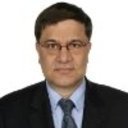Scoliosis in Steinert syndrome: a case report.
Anahtar kelimeler
Öz
BACKGROUND
Steinert syndrome is described as an autosomal dominant condition characterized by progressive muscular wasting, myotonia, musculoskeletal manifestations and rare spinal defects. Little is reported about spinal deformity associated with this syndrome.
OBJECTIVE
We present a patient with Steinert syndrome complicated by scoliosis. In the literature on muscular dystrophy, other than Duchenne, little mention is given to the problem of scoliosis in general and its treatment in particular.
METHODS
A case report of a patient with Steinert syndrome associated with thoracic scoliosis and hypokyphosis is presented.
METHODS
A 17-year-old boy presented with King type II right thoracic scoliosis (T5-T11, Cobb angle of 40 degrees) and hypokyphosis--10 degrees. He was treated with posterior stabilization and instrumentation at level T3-L2 with a postoperative correction of the scoliotic curve to 20 degrees. Histopathologic examination of the muscles confirmed the diagnosis of Steinert myotonic dystrophy.
RESULTS
At 30-month follow-up, the patient was clinically pain free and well balanced. Plain radiographs showed solid spine fusion with no loss of deformity correction.
CONCLUSIONS
Scoliosis in Steinert syndrome shares the characteristic of an arthrogrypotic neuromuscular curve and demands the extensive soft tissue release for optimal surgical correction. Intraoperative observations included profound tissue bleeding, abnormally tough soft tissues and a difficult recovery from anaesthesia.



